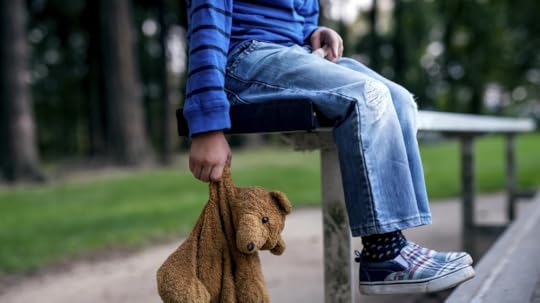Daniel Rolph's Blog, page 2
October 10, 2024
What to Expect: Understanding Short Term and Long Term Foster Care for Parents
Foster care can be a nurturing opportunity for both children in need and families willing to open their hearts and homes to support them. As a parent considering foster care, it's essential to understand the different paths available: short term foster care and long term foster care. Let's dive into what each option entails and what you can expect as you embark on this fulfilling journey.
Short Term Foster Care: A Temporary Home for Hope
Short term foster care provides children with a temporary safe haven while permanent arrangements are made for them. As a short term foster parent, you play a crucial role in providing stability and care during a transitional period. This type of fostering is usually for a shorter duration, ranging from a few days to a couple of months, depending on the child's situation.
What to Expect in Short Term Foster Care:
Emotional Support: Children in short term foster care often arrive with emotional needs stemming from their experiences. Your role is to provide a nurturing environment and emotional support during this time of uncertainty.
Flexibility: Short term foster care requires a flexible mindset as you may need to adapt to changes in the child's circumstances or care plan.
Collaboration: Working closely with social workers and other professionals is crucial to ensure the child's needs are being met effectively.
Transition Planning: As a short term foster parent, you may also be involved in transition planning to ensure a smooth move for the child when they transition to their next placement.

Long Term Foster Care: Building Bonds That Last a Lifetime
Long term foster care provides children with a stable and secure home environment for an extended period. As a long term foster parent, you have the opportunity to form lasting relationships with the child and support them through various stages of their development.
What to Expect in Long Term Foster Care:
Building Relationships: Long term foster care allows you to build strong and enduring relationships with the child, providing them with a sense of permanency and belonging.
Advocacy: Advocating for the child's needs and rights becomes an integral part of your role as a long term foster parent.
Consistency: Providing a consistent and stable environment is essential for the child's growth and well-being.
Commitment: Long term foster care requires a long-term commitment to the child, offering them the support and care they need over an extended period.
Final Thoughts
Both short term and long term foster care play vital roles in providing children with the care and support they need during challenging times in their lives. As a parent considering foster care, understanding the differences between these two options can help you make an informed decision that aligns with your capabilities and aspirations. Remember, whether you choose short term or long term foster care, your dedication and love can make a significant impact on a child's life.
September 5, 2024
The Healing Journey of Foster Kids: A Story of Resilience and Hope
Imagine a world where every child feels loved and cherished, where every heartache is soothed, and every dream is nurtured. But what happens when a child's reality is far from this ideal? This is the poignant reality that countless foster kids face every day. Today, we delve into the emotional rollercoaster, the hurdles, and the triumphs that make up the healing journey of foster kids.
The Beginning: A Journey of Confusion and Heartbreak
For many foster kids, the journey begins with confusion and heartbreak. Separated from their families for reasons beyond their control, they find themselves in an unfamiliar world filled with uncertainty. Imagine a young child trying to make sense of a world turned upside down, where stability and safety are fleeting concepts. It's a harsh beginning, but within this darkness lies a spark of resilience that is truly remarkable.
The Struggle: Overcoming Adversity with Strength and Courage
The road to healing for foster kids is paved with challenges that would daunt even the bravest of souls. From navigating multiple placements to coping with the trauma of their past, every step forward is a testament to their strength and courage. It's a journey filled with setbacks and obstacles, but it's also a journey that showcases the indomitable spirit of these resilient children.
The Turning Point: Finding Hope and Healing
But amidst the darkness, there is light. The turning point in the healing journey of foster kids is often marked by a moment of connection, understanding, and hope. It's a moment when they realize that they are not defined by their past, but by the boundless potential within them. With the support of dedicated individuals and the power of their own resilience, foster kids begin to heal, to grow, and to thrive.
The Power of Connection: Building Trust and Resilience
Central to the healing journey of foster kids is the power of connection. Whether it's a caring foster parent, a supportive caseworker, or a kind-hearted mentor, these meaningful relationships play a crucial role in helping foster kids heal and thrive. Through the bonds they form, foster kids learn to trust, to open their hearts to love, and to believe in a brighter future.
Celebrating Victories: Small Wins and Big Achievements
Every step forward, no matter how small, is a victory in the healing journey of foster kids. From mastering a new skill to graduating from high school, each accomplishment is a testament to their resilience, determination, and unwavering spirit. These victories, both big and small, deserve to be celebrated, for they signify the strength and courage that define the path of healing.
A Brighter Future: The Promise of Tomorrow
As we reflect on the healing journey of foster kids, we are filled with hope and optimism for the future. These remarkable children have shown us the power of resilience, the importance of connection, and the beauty of hope. While their journey may be marked by challenges, it is also illuminated by moments of triumph and joy. And as they continue on their path of healing, we stand beside them, ready to offer support, love, and encouragement every step of the way.
The healing journey of foster kids is a testament to the strength of the human spirit, the power of resilience, and the beauty of hope. It is a journey marked by challenges and victories, heartbreak and joy, but above all, it is a journey filled with endless possibilities. And as we walk alongside these remarkable children, we are reminded that with love, support, and understanding, anything is possible.
Remember, every child deserves to feel loved, cherished, and hopeful. Let's continue to support and uplift the healing journey of foster kids everywhere.
August 22, 2024
The Silent Struggles of Foster Kids: Understanding Trauma, Resilience, and Healing
Growing up in the foster care system was a journey that shaped every aspect of who I am today. It was a path filled with unexpected twists, deep emotional scars, and the constant battle between hope and despair. My story is not just mine alone—it's the story of countless children who, like me, have been thrust into a system that often fails to protect them. In this blog, I want to share my experiences and offer insights to current foster parents about the profound impact trauma can have on children in their care.

One of the most challenging aspects of growing up in foster care is the constant displacement. Moving from one home to another, never having a place to call your own, creates an overwhelming sense of instability. As a child, I often felt like a piece of luggage being passed around, never staying in one place long enough to unpack emotionally. This constant movement can lead to feelings of worthlessness and fear, as each new home comes with its own set of uncertainties.
Each time I was moved, I had to start over—new faces, new rules, new expectations. The emotional toll of repeatedly saying goodbye to people I barely had the chance to know was exhausting. For children in foster care, this instability can make it difficult to form meaningful attachments, leading to a deep sense of isolation and mistrust.
Even short stays in foster care can leave lasting scars. I remember being placed in a foster home for just a week, but that week felt like a lifetime. The fear of being forgotten or lost in the system was overwhelming. Short stays, though brief, can create a profound sense of insecurity in children. They never know if or when they’ll be taken away again, making it difficult for them to feel safe or trust the adults around them.
For foster parents, it's important to understand that even short-term placements can have a significant impact on a child's sense of stability and security. These children need reassurance, consistency, and the knowledge that someone cares about their well-being.
One of the darkest realities of my time in foster care was witnessing and experiencing physical abuse. The foster care system is supposed to be a refuge, a safe place for children who have already endured so much. But for many, it becomes another source of trauma. I remember crouching in the corner of a room, trying to make myself as small as possible as I watched other children being hit. The fear was paralyzing, and the helplessness was overwhelming.
This kind of abuse leaves deep emotional scars that can take years to heal. It creates an environment of fear and mistrust, where children learn that the world is not a safe place. For foster parents, it's crucial to create a home where children feel protected and valued. Understanding the signs of trauma and being equipped to address them can make all the difference in a child's life.
For me, stealing food wasn’t about hunger—it was about control. In a world where everything felt uncertain, where I had no say in where I lived or who I lived with, food became something I could control. It was a way to assert some semblance of power in a powerless situation. The act of stealing gave me a brief moment of security, knowing that I had something, however small, that was mine.
This relationship with food is not uncommon among children in foster care. For many, food becomes a symbol of security in a world where security is often lacking. Foster parents can help by providing consistent, nurturing meals and by understanding that behaviours like hoarding or stealing food are not just about hunger—they're about a deep-seated need for control and stability.
The foster care system is supposed to be a refuge, a safe place for children who have already endured so much
Growing up, I struggled with understanding and expressing my emotions. There was a disconnect between what I felt and how I could communicate it. This often led to moments where I would either shut down completely or react in ways that I didn’t fully understand. Physical touch was another complex issue. While I craved connection, the act of someone reaching out to comfort me often felt overwhelming or even threatening.
For children who have experienced trauma, emotions and physical touch can be incredibly complicated. Foster parents need to approach these children with patience and empathy, understanding that their reactions may be rooted in past traumas. Building trust takes time, but with consistent care and support, these children can learn to navigate their emotions and form healthy attachments.
School was another battleground for me. Sitting in a classroom, surrounded by other children who seemed to have it all together, I often felt the walls closing in around me. The fear and anxiety would build up until it became unbearable, and I would have to escape. This overwhelming sense of dread made it difficult for me to focus, to learn, or to feel like I belonged.
For foster children, school can be a source of additional stress. The challenges they face at home often spill over into the classroom, making it hard for them to keep up with their peers. Teachers and foster parents need to work together to create a supportive learning environment where these children can thrive. Understanding the impact of trauma on learning and behaviour is key to helping foster children succeed academically.
As a former foster child, I know firsthand the impact that trauma can have on a child's life. But I also know that with the right support, these children can overcome their past and build a brighter future. Foster parents play a crucial role in this process. By understanding the realities of trauma and providing a safe, nurturing environment, you can help these children heal and grow.
Trauma-informed care is not just a buzzword—it's a necessary approach to foster parenting that acknowledges the complex emotional needs of children who have experienced trauma. It means being aware of the signs of trauma, understanding how it affects behaviour, and knowing how to respond in a way that supports healing. It means recognizing that every child is different and that what works for one child may not work for another.
But most importantly, it means offering love, patience, and consistency. Children in foster care need to know that they are valued, that they are safe, and that they are loved. They need to know that someone is in their corner, no matter what.
Sharing my story is not just about reflecting on my past—it's about giving a voice to the countless children who are still in the system, still facing the same challenges I did. These children are not just statistics; they are individuals with hopes, dreams, and the same need for love and security as anyone else. By raising awareness and providing support, we can help these children navigate their trauma and build a brighter future.
Foster parents, you have the power to make a difference. By being trauma-informed, by offering stability and love, you can help these children find their way in a world that has often let them down. It's not an easy journey, but it's one worth taking—for the sake of the children who need you the most.
August 18, 2024
The Realities of the Foster Care System: What Shattered Paths Reveals About Childhood Trauma
When I wrote Shattered Paths, I didn’t just want to tell a story—I wanted to shine a light on the hidden and often misunderstood realities of the foster care system. Through the experiences of my characters, I sought to explore the profound impact that childhood trauma can have on children who navigate this system. This is a reality that many face but few fully understand. Today, I want to delve deeper into what my book reveals about the foster care system and the trauma that often accompanies it.

Children in the foster care system often endure experiences that many of us can’t even begin to imagine. From neglect and abuse to the simple but devastating reality of being removed from their homes, these children face a range of traumatic events that can leave lasting scars. According to a study by the Australian Institute of Family Studies, trauma in children can affect brain development, leading to long-term consequences on their emotional and psychological well-being.
Trauma isn’t just about the events themselves; it’s about the way these events are processed and internalized. For children in foster care, the constant upheaval—moving from one home to another, forming attachments only to have them broken—creates an environment where trust is fragile, and security is elusive. This lack of stability can exacerbate feelings of fear, helplessness, and abandonment, which are common in children who have experienced trauma.
Trauma can have a profound effect on a child's brain development. The brain is highly adaptive, particularly in childhood, and traumatic experiences can alter the way the brain functions. According to research from the Australian Institute of Family Studies, trauma can cause the brain to remain in a constant state of high alert, often referred to as "fight or flight" mode. This heightened state of stress can impair cognitive development, emotional regulation, and the ability to form healthy relationships.
In Shattered Paths, Jack, one of the central characters, embodies the long-term effects of such trauma. His struggle to trust others and his constant readiness for rejection are reflective of the neurological and psychological impacts that trauma has on children in foster care. These children often develop survival mechanisms that, while protective in the short term, can hinder their emotional and social growth in the long run.
I wanted to shine a light on the hidden and often misunderstood realities of the foster care system - Daniel Rolph
Despite the challenges, one of the most remarkable aspects of children in the foster care system is their resilience. Resilience doesn’t mean that these children are unaffected by their experiences—far from it. It means that they have developed the ability to adapt and survive in the face of adversity. This resilience is often seen as a coping mechanism, a way for children to regain some sense of control in an unpredictable world.
In Shattered Paths, Emma represents this resilience. Despite the trauma she has faced, she clings to hope and finds ways to navigate her world. Her story is a testament to the incredible strength that children in the foster care system often possess. But it’s important to understand that resilience is not an innate trait; it’s developed through supportive relationships, a sense of belonging, and the ability to make sense of one’s experiences. For children in care, fostering resilience is key to their healing and growth .
One of the critical issues highlighted in Shattered Paths is the systemic challenges that exacerbate the trauma children face. The foster care system, while well-intentioned, is often overburdened and under-resourced. This can lead to children being placed in multiple homes, sometimes with foster carers who are not adequately trained to deal with the complex needs of traumatized children .
The constant movement from home to home, the uncertainty of their future, and the lack of consistent, nurturing relationships can create an environment where trauma is not just an isolated event but a recurring theme. This instability further compounds the difficulties these children face, making it even harder for them to develop trust and feel secure .
Through Shattered Paths, I wanted to give a voice to the countless children who, like me, have navigated the foster care system and faced the trauma it so often entails. I wanted to highlight not just their struggles but also their strength, their resilience, and their capacity for hope. These children are often silenced by the very system that is meant to protect them, and their stories are too often left untold.
Writing Shattered Paths was a way for me to process my own experiences and, more importantly, to bring attention to the broader issues at play. The foster care system is far from perfect, but by raising awareness and understanding, we can start to make changes that will better support these vulnerable children. It’s about more than just survival; it’s about giving these children the chance to thrive, to build meaningful relationships, and to heal from the wounds of their past .
The foster care system needs reform, but more than that, it needs compassion. Children who have experienced trauma require more than just a roof over their heads—they need stability, understanding, and support. They need foster carers who are equipped to handle their complex needs, and they need a system that prioritizes their well-being above all else.
In Shattered Paths, I explore the harsh realities of the foster care system, but I also want to shine a light on the possibilities for change. By understanding the impact of trauma and fostering resilience, we can create a system that truly supports these children. It starts with awareness, continues with education, and requires the collective effort of society to ensure that no child is left to navigate their path alone.
August 13, 2024
Why I Wrote Shattered Paths: A Personal Journey Through the Foster Care System

When I first began writing Shattered Paths, I knew it wouldn’t be an easy journey. This book isn’t just a work of fiction; it’s a deeply personal story that reflects my own experiences growing up in the UK foster care system. Writing Shattered Paths was a way for me to process and share the emotions, challenges, and resilience that defined my childhood. It’s a story I’ve carried with me for years, and now, I want to share it with the world.
I entered the foster care system at a very young age, and like so many others, I quickly learned that the world can be a harsh and unforgiving place. The foster care system is supposed to provide safety and stability for children who have been removed from their families, but all too often, it falls short of that promise. For many, including myself, the system became a source of trauma rather than a refuge. Moving from one foster home to another, I experienced rejection, neglect, and the relentless search for a place where I truly belonged.
As a child, I often felt invisible—lost in a system that didn’t see me as an individual but as just another case file. I was one of many children struggling to find love and security in a world that seemed determined to withhold both. These experiences left deep scars, but they also taught me the importance of resilience and hope. It’s this resilience that I wanted to capture in Shattered Paths.
When I first began writing Shattered Paths, I knew it wouldn’t be an easy journey.
The characters in Shattered Paths—Jack, Emma, and Oliver—are fictional, but their stories are rooted in reality. They represent the countless children who, like me, were let down by a system that was supposed to protect them. Each of them faces unique challenges, yet their stories are intertwined by a common thread of survival and the pursuit of belonging. Writing their stories allowed me to explore the emotions I had long buried and to give a voice to those who have been silenced by their circumstances.
But Shattered Paths is not just about my experience or the experiences of children in the UK foster care system. It’s about a much larger issue—one that affects children worldwide. Foster care systems exist in many countries, and while they are meant to provide a safety net for vulnerable children, the reality is often far different. Children in care, regardless of where they are in the world, frequently face similar challenges: instability, neglect, and a lack of a permanent, loving home.
These children, whether in the UK, the United States, Australia, or anywhere else, often go unheard. Their stories are rarely told, and their voices are often lost in the bureaucracy and red tape that surrounds them. With Shattered Paths, I wanted to shine a light on these forgotten voices and bring their stories to the forefront. This book is my attempt to give a voice to the voiceless—not just in the UK, but globally.
Through Shattered Paths, I hope to raise awareness about the struggles faced by children in foster care around the world. These children are not just statistics; they are individuals with hopes, dreams, and the same desire for love and belonging that we all share. By sharing their stories, I hope to inspire empathy, understanding, and, ultimately, change.
The foster care system, in many places, is in desperate need of reform. But before change can happen, there must be awareness. People need to understand the realities of what these children go through. They need to hear the stories of those who have been through the system and come out the other side—scarred, perhaps, but also stronger. Shattered Paths is my way of starting that conversation, of bringing these stories into the light where they belong.
Writing this book was a therapeutic process, one that allowed me to revisit my past and reflect on how far I’ve come. It also reinforced my belief that stories like mine need to be told. There are so many children out there who are still living through these experiences, and their voices need to be heard.
I hope that Shattered Paths will resonate with readers, not just as a compelling story, but as a call to action. The foster care system is far from perfect, and it’s our responsibility as a society to ensure that all children have the opportunity to grow up in a safe and loving environment. By sharing my story through the pages of Shattered Paths, I hope to contribute to that change and to bring attention to the children who are still navigating their own shattered paths—no matter where in the world they may be.



